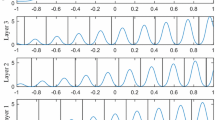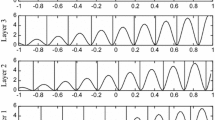Abstract
The cerebellar model articulation controller, or CMAC, is a type of associative memory neural network suitable for use in direct adaptive control schemes. However, the CMAC exhibits a large trade-off between stability and performance when inputs oscillate. This is due to the local nature of the basis functions—an input oscillating between two basis functions on one layer can cause their weights to drift in opposite directions. Continued drift will eventually affect performance, resulting in bursting. The proposed method overlaps the basis functions on each layer so that an oscillation will occur within basis functions. This makes the weights much less prone to drift. A simulation with a flexible joint demonstrates that both high performance and stability can be achieved using the proposed method.













Similar content being viewed by others
Explore related subjects
Discover the latest articles, news and stories from top researchers in related subjects.References
Abdelhameed MM, Pinspon U, Cetinkunt S (2002) Adaptive learning algorithm for cerebellar model articulation controller. Mechatronics 12:859–873
Albus J (1975) Data storage in the cerebellar model articulation controller (CMAC). J Dyn Syst Meas Control 97:228–233
Albus J (1975) A new approach to manipulator control: the cerebellar model articulation controller (CMAC). J Dyn Syst Meas Control 97:220–227
Chen F, Chang C (1996) Practical stability issues in CMAC neural network control systems. IEEE Trans Control Syst Technol 4:86–91
Chiu CH (2010) The design and implementation of a wheeled inverted pendulum using an adaptive output recurrent cerebellar model articulation controller. IEEE Trans Ind Electron 57(5):1814–1822
Egardt B (1979) Stability of adaptive controllers. Springer, New York
Hsu CF (2012) Adaptive dynamic CMAC neural control of nonlinear chaotic systems with L2 tracking performance. Eng Appl Artif Intell 25(5):9971008
Huang YW, Juang JG (2014) Twin rotor system control based on self-organizing CMAC. In: International conference on machine learning and cybernetics, pp 876–882, Lanzhou
Ioannuou P, Kokotovic P (1984) Instability analysis and improvement of robustness of adaptive control. Automatica 20(5):583–594
Jiang Z, Wang S (2003) A general learning scheme for CMAC-based controller. Neural Process Lett 18:125138
Kim Y, Lewis F (2000) Optimal design of CMAC neural-network controller for robot manipulators. IEEE Trans Syst Man Cybern C 30(1):22–30
Kraft L, Pallotta J (2000) Real-time vibration control using CMAC neural networks with weightsmoothing. In: Proceedings of IEEE American control conference, pp 3939–3943. Chicago
Lane SH, Handelman DA, Gelfand JJ (1992) Theory and development of higher-order CMAC neural networks. IEEE Control Syst Mag 12(2):23–30
Lewis F, Jagannathan S, Yesildirek A (1999) Neural network control of robot manipulators and nonlinear systems. Taylor and Francis, Philidelphia
Lin CM, Li HY (2014) Adaptive dynamic sliding-mode fuzzy CMAC for voice coil motor using asymmetric gaussian membership function. IEEE Trans Ind Electron 61(10):5662–5671
Macnab C (2009) Preventing bursting in approximate-adaptive control when using local basis functions. Fuzzy Sets Syst 160:439–462
Macnab C (2011) Neural-adaptive control using alternate weights. Neural Comput Appl 20(2):211–231
Meng A, Yang J, Li M, Jiang S (2016) Research on hysteresis compensation control of gmm. Nonlinear Dyn 83:161–167
Narendra K, Annaswamy A (1987) A new adpative law for robust adaptation without persistant excitation. IEEE Trans Autom Control AC–32(2):134–145
Ngo T, Phuong T (2015) Robust adaptive self-organizing wavelet fuzzy CMAC tracking control for de-icing robot manipulator. Int J Comput Commun Control 10(4):567–578
Peng YF, Lin CM (2007) Adaptive recurrent cerebellar model articulation controller for linear ultrasonic motor with optimal learning rates. Neurocomputing 70:6262637
Shiev K, Ahmed S, Shakev N, Topalov AV (2016) Trajectory control of manipulators using an adaptive parametric type-2 fuzzy cmac friction and disturbance compensator. In: Hadjiski M, Kasabov N, Filev D, Jotsov V (eds) Novel applications of intelligent systems, studies in computational intelligence. Springer, New York, pp 63–82
Taoa T, Su SF (2011) CMAC-based previous step supervisory control schemes for relaxing bound in adaptive fuzzy control. Appl Soft Comput 11(8):57155723
Wang SY, Tseng CL, Chiu CJ (2015) Online speed controller scheme using adaptive supervisory tsk-fuzzy CMAC for vector controlled induction motor drive. Asian J Control 17(2):569–581
Wang SY, Tseng CL, Tseng CH, Chou JH, Tsai MH (2013) Design and implementation of adaptive fuzzy cerebellar model articulation controller for direct torque control system. Appl Mech Mater 300–301:1444–1447
Wen CM, Cheng MY (2013) Development of a recurrent fuzzy CMAC with adjustable input space quantization and self-tuning learning rate for control of a dual-axis piezoelectric actuated micromotion stage. IEEE Trans Ind Electron 60(11):5105–5115
Wu TF, Huang HC, Tsai PS, Hu NT, Yang ZQ (2014) Adaptive fuzzy cmac design for an omni-directional mobile robot. In: International conference on intelligent information hiding and multimedia signal processing, pp 839–843. Kitakyushu
Yang B, Bao R, Han H (2014) Robust hybrid control based on PD and novel CMAC with improved architecture and learning scheme for electric load simulator. IEEE Trans Ind Electron 61(10):5271–5279
Yeh MF, Lu HC (2008) On-line learning CMAC control system. In: International conference on intelligent engineering systems, pp 115–120. Miami
Yu W, Moreno-Armendariz MA, Rodriguez FO (2011) Stable adaptive compensation with fuzzy CMAC for an overhead crane. Inf Sci 181:48954907
Yuan Y, Gu W, Yu J (2004) Online learning CMAC neural network control scheme for nonlinear systems. Lecture notes in computer science. In: Yin F, Wang J, Guo C (eds) Advanced neural network. Springer, Berlin, pp 117–122
Author information
Authors and Affiliations
Corresponding author
Ethics declarations
Conflict of interest
C.J.B. Macnab declares that he has no conflict of interest.
Human and animal rights
This article does not contain any studies with human participants or animals performed by any of the authors.
Additional information
Communicated by A. Di Nola.
Rights and permissions
About this article
Cite this article
Macnab, C.J.B. Creating a CMAC with overlapping basis functions in order to prevent weight drift. Soft Comput 21, 4593–4600 (2017). https://doi.org/10.1007/s00500-016-2204-0
Published:
Issue Date:
DOI: https://doi.org/10.1007/s00500-016-2204-0




